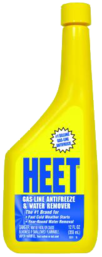Methanol
Methanol, or methyl alcohol is the simplest alcohol, with the formula CH3OH, also abbreviated as MeOH. It is a light, colorless, volatile, flammable liquid. It is an important chemical as a solvent and feedstock organic compound.[1]
Contents
Properties
Chemical
Methanol is a starting point for many organic compounds, such as formaldehyde, which is produced by oxidation of methanol. Methanol vapors in air will decompose over the course of several days to form carbon dioxide and water vapor.[2]
Physical
Methanol is a colorless, volatile, flammable liquid. It has a molecular weight of 32.04, a boiling point of 65°C and a density of .7914g/cm3[3]. Methanol/water mixtures can be separated into two layers by salting-out with potassium carbonate.
Availability
A type of antifreeze and automotive cleaner known as Heet can be found in most gas stations in the United States and is 99% or higher methanol. Some alternative fuels are entirely or mostly made of methanol, and due to the large quantities typically sold this can be a very efficient way to purchase it. Methanol is sometimes sold at paint supply stores as wood alcohol, or methyl alcohol.[4] It can also be bought from scientific suppliers in higher grades. Hardware supplies sometimes sell methanol as "methyl hydrate" or "methylated spirits". Finally, some home fireplaces use methanol as fuel, so it can be found in this manner as well.
Preparation
Impure methanol can be obtained via destructive distillation of wood. The process is not economically viable on a small scale, and produces many side products/contaminants, acetic acid, acetone, and tars among them. It is still an interesting process though, and could be attempted solely for educational value.[5]
Projects
- Make formaldehyde
- Make trimethyl borate
- Make methyl salicylate and other methyl esters
Handling
Safety
Methanol is significantly more toxic than other common alcohols such as ethanol or isopropanol, as it is metabolized to formic acid in the body, causing blindness and death at high doses.
Methanol flames tend to have extremely low visibility, particularly in the daytime or well-lit environments, making burning methanol difficult to detect and posing a great risk. If it is being used in instances where burning is likely, the addition of a small amount of boric acid colors the flame green and allows it to be seen.
Storage
Methanol is best kept in glass bottles in dark places. Methanol should be kept out of rooms with an open flame, as it is highly volatile and flammable.
Disposal
Burning methanol is a good way to destroy it. A good tip is to make the flame visible and try not to burn too much at once, to prevent its vaporization in the air.
References
- ↑ http://en.wikipedia.org/wiki/Methanol
- ↑ http://pubchem.ncbi.nlm.nih.gov/summary/summary.cgi?cid=887&loc=ec_rcs#itabs-2d
- ↑ CRC Handbook of Chemistry and Physics 66th Edition, 1985
- ↑ http://en.wikipedia.org/wiki/List_of_commonly_available_chemicals#L.E2.80.93N
- ↑ http://www.sciencemadness.org/talk/viewthread.php?tid=2652
Relevant Sciencemadness threads
- Methanol -> methanal(formaldehyde)
- Destructive Distillation of Wood
- Methanol Synthesis(Newer thread)
